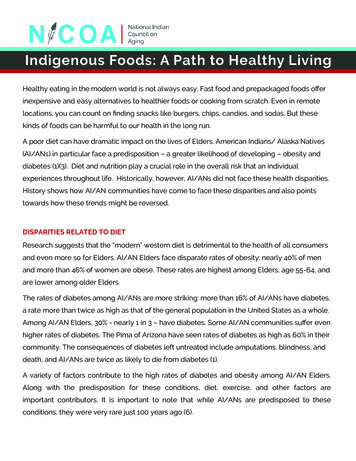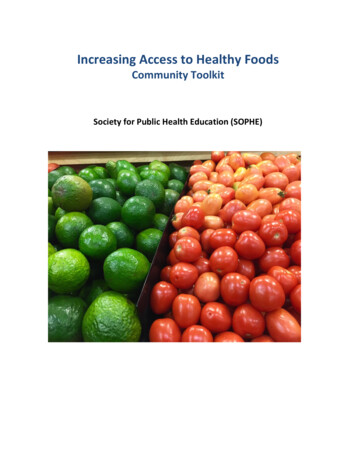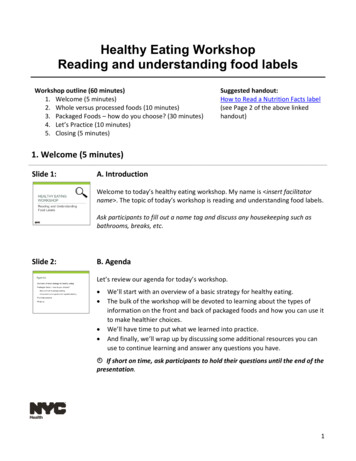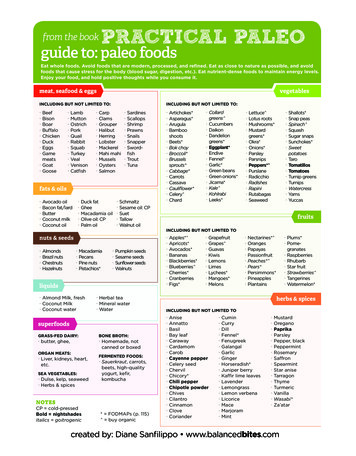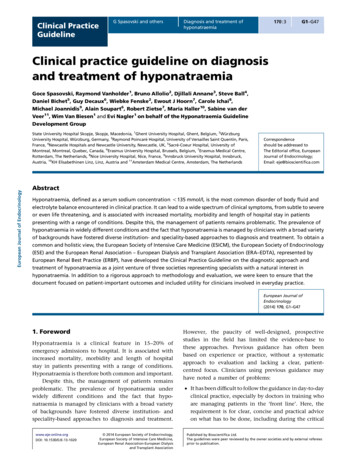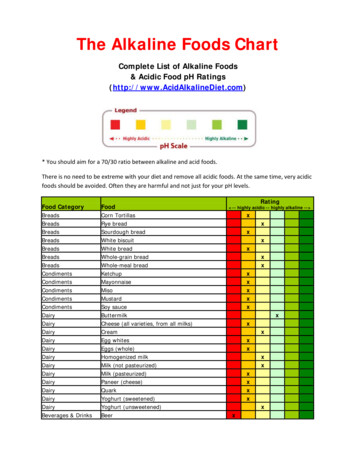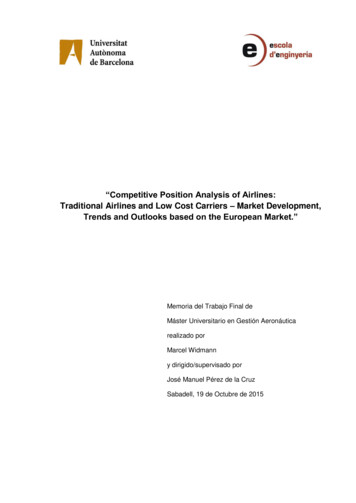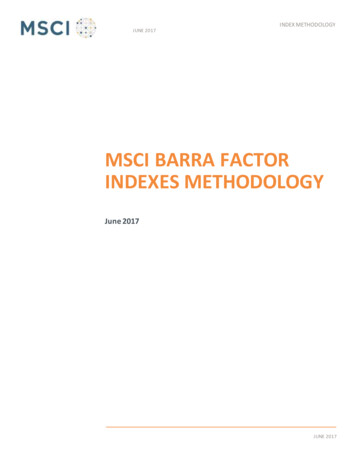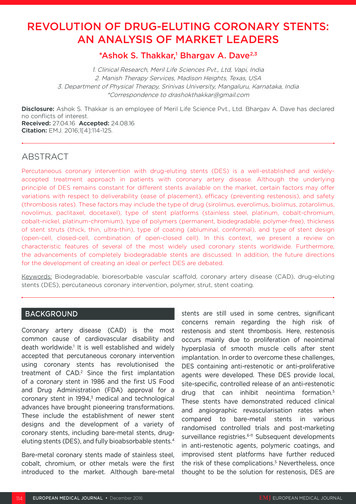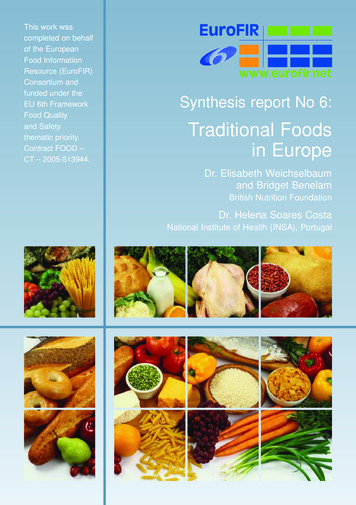
Transcription
This work wascompleted on behalfof the EuropeanFood InformationResource (EuroFIR)Consortium andfunded under theEU 6th FrameworkFood Qualityand Safetythematic priority.Contract FOOD –CT – 2005-513944.Synthesis report No 6:Traditional Foodsin EuropeDr. Elisabeth Weichselbaumand Bridget BenelamBritish Nutrition FoundationDr. Helena Soares CostaNational Institute of Health (INSA), Portugal
Synthesis Report No 6Traditional Foods in EuropeDr. Elisabeth Weichselbaum and Bridget BenelamBritish Nutrition FoundationDr. Helena Soares CostaNational Institute of Health (INSA), PortugalThis work was completed on behalf of the European Food InformationResource (EuroFIR) Consortium and funded under the EU 6th FrameworkFood Quality and Safety thematic priority. Contract FOOD-CT-2005-513944.
Traditional Foods in EuropeContents1Introduction 22What are traditional foods? 43Consumer perception of traditional foods 74Traditional foods across Europe 9Austria/Österreich 14Belgium/België/Belgique 17Bulgaria/БЪЛГАРИЯ 21Denmark/Danmark 24Germany/Deutschland 27Greece/Ελλάδα 30Iceland/Ísland 33Italy/Italia 37Lithuania/Lietuva 41Poland/Polska 44Portugal/Portugal 47Spain/España 51Turkey/Türkiye 545 Why include traditional foods in European foodcomposition databases? 596Health aspects of traditional foods 607Open borders in nutrition habits? 628Traditional foods within the EuroFIR network 64References 67Annex 1 ‘Definitions of traditional foods and products’ 711
Traditional Foods in Europe1. IntroductionTraditions are customs or beliefs taught by one generation to the next, oftenby word of mouth, and they play an important role in cultural identification.Each culture, ethnic group or region has specific traditions. Some traditions,such as religious customs, overlap different cultures, ethnic groups orregions.Specific eating habits play an important role in the traditional habits of manycultures. The use of particular food ingredients and food preparationmethods has been passed on from one generation to the next, and arenowadays referred to as ‘traditional foods’.Traditional foods have played a major role in traditions of different culturesand regions for thousands of years. They include foods that have beenconsumed locally and regionally for an extended time period. Preparationmethods of traditional foods are part of the folklore of a country or a region.Unfortunately, throughout Europe, some traditional foods are at risk ofdisappearing due to altered lifestyles. Therefore, it is important to study anddocument traditional foods to sustain important elements of Europeancultures.Most people can probably name at least one traditional food of the regionthey come from. Searching the internet for ‘traditional foods’ shows thatnumerous collections of traditional food recipes are available from countriesworldwide. However, defining traditional foods is not as easy as it might bepresumed. There are very few definitions available, and most of them havebeen developed relatively recently. One of these definitions has beenprepared by EuroFIR. This EuroFIR definition is presented in chapter 2 andother definitions of ‘traditional foods’ can be found in annex 1. Chapter 3summarises results of a consumer survey on the perception of traditionalfoods carried out in European countries.2
Traditional Foods in EuropeIn chapter 4, an overview of traditional foods in selected European countriescan be found. This includes a brief history of traditional foods in thesecountries, i.e. which other cultures influenced the traditional cuisine or whichhistorical events (e.g. the discovery of the ‘New World’) had an impact ontraditional foods in Europe. Examples of five selected traditional foods fromeach country are presented in this chapter.In the last part of the report, health aspects as well as the need to includetraditional foods in European food composition databases are discussed.Also outlined in this Synthesis Report are the effects of globalisation ontraditional foods and eating habits in Europe and consumers’ perception oftraditional foods.The aim of this report is to give an overview of traditional foods acrossEurope.3
Traditional Foods in Europe2. What are traditional foods?Although the term ‘traditional foods’ is widely used, and everybody has arough idea of what is meant by it, there are hardly any definitions that clearlydefine traditional foods.EuroFIR definitionOne of the main aims of the European Food Information Resource (EuroFIR)Network of Excellence has been the establishment of a pan-European foodinformation resource in the form of a portal, allowing access to online foodcomposition data across Europe. The importance of including compositiondata for traditional European foods has been recognised, and therefore awork package concentrating on traditional foods was set up at the onset ofthe project.A first step of the EuroFIR Traditional Foods work package was thedevelopment of a definition of the term ‘traditional foods’ (Trichopoulou et al.2007). A clear definition was essential to select and further collect informationabout traditional foods, such as ingredients, preparation methods and foodcomposition data.The EuroFIR definition of traditional foods was acknowledged by the Foodand Agriculture Organization (FAO) at the 26th FAO Regional conference forEurope in Innsbruck, Austria, on the 26th-27th June 2008.EuroFIR definition of ‘Traditional food’LLTRADITIONAL FOODTraditional means conforming to established practice or specifications priorto the Second World War. Traditional food is a food with a specific feature or4
Traditional Foods in Europefeatures, which distinguish it clearly from other similar products of the samecategory in terms of the use of ‘traditional ingredients’ (raw materials ofprimary products) or ‘traditional composition’ or ‘traditional type of productionand/or processing method’ as defined below.TRADITIONAL INGREDIENT (RAW MATERIAL OR PRIMARYPRODUCT)Raw material (species and/or varieties) or primary product, either aloneor as an ingredient, which has been used in identifiable geographicalareas and remains in use today (taking into account cases where usewas abandoned for a time and then reinstated) and its characteristicsare in accordance with current specifications of national and EUlegislation.TRADITIONAL COMPOSITIONThe uniquely identifiable composition (in terms of ingredients) that wasfirst established prior to the Second World War and passed downthrough generations by oral or other means (taking into account caseswhere composition was abandoned for a time and then reinstated) andwhen necessary is differentiated from the composition defined by thegenerally recognised characteristics of the wider food group to whichthe product belongs.TRADITIONAL TYPE OF PRODUCTION AND/OR PROCESSINGThe production and/or processing of a food that:– Has been transmitted from generation to generation through oraltradition or other means and– Has been applied prior to the Second World War and remains inuse (taking into account cases where composition was abandoned5
Traditional Foods in Europefor a time and then reinstated) despite its adjustment to bindingrules from national or EU food hygiene regulations or theincorporation of technological progress, under the condition thatproduction and/or processing remains in line with methods usedoriginally and that the food’s intrinsic features such as its physical,chemical, microbiological or organoleptic features aremaintained.Further definitions of traditional foods and products can be found inannex 1.6
Traditional Foods in Europe3. Consumer perception of traditional foodsDefinitions of traditional foods may not necessarily reflect the opinions ofconsumers. In the course of TRUEFOOD, an integrated project aiming tointroduce suitable innovations into the traditional food industry, a surveyexamining the perception of traditional foods among consumers was carriedout in 6 European countries (Belgium, Italy, France, Spain, Poland andNorway). In each country, around 800 participants aged 20-70 years wereinterviewed (Vanhonacker et al. 2008).The TRUEFOOD working definition of traditional foods, which is based onlocal production, authenticity, commercial availability and gastronomicheritage (see annex 1), was largely confirmed in this quantitative panEuropean study. The study revealed that European consumers seem todefine traditional foods as well-known foods, that one can eat often and thatwere already eaten by grandparents. In contrast, attributes such as naturaland low-processed were less strongly associated with traditional foods. Theleast cross-country differences were found for statements related to thecommon character of the product and its long existence; these are thestatements most strongly associated with traditional foods. The highestbetween-country discrepancies were found for specific characters of theproduct such as specific sensory properties. These were strongly associatedwith traditional foods among Polish consumers, and were associated to alesser degree in Italy, France and Spain. The weakest associations betweenspecific sensory properties and traditional foods were found in Belgium andNorway. The same trend was found for the association of traditional foodswith special occasions and those that contain a story (Vanhonacker et al.2008).Overall, the image of traditional foods seemed to be very positive in all theexamined countries. More detailed results of the survey can be found intable 1.7
Traditional Foods in EuropeTable 1: Consumer perception of traditional food products in Belgium(BE), France (FR), Italy (IT), Norway (NO), Poland (PL) and Spain (ES).Expressed as mean association on a scale of 1-7 (1 don’t agree, 7 totallyagree). The highest association is black bold, the lowest grey italic.ItemBEFRITNOPLESWhen I think about traditional food, I thinkabout food products that my parents andgrandparents already ate5.845.755.676.106.146.05I consider traditional food as well-known food5.585.465.595.795.745.84The availability of traditional food is stronglydependent on the season5.495.905.685.115.195.65According to me, traditional food is typicallysomething one can eat very often5.375.535.184.984.795.45Traditional food has an authentic recipe5.075.495.785.265.845.80To me, a traditional food product is associatedwith specific sensory properties4.935.575.715.175.955.73Traditional food has an authentic origin ofraw material4.805.365.445.245.615.39A traditional food product is typicallyproduced ‘in grandmother’s way’4.705.395.365.175.875.55Traditional food has an authenticproduction process4.655.045.394.985.395.21The key steps of the production of traditionalfood must be done locally4.455.055.204.104.905.31When it comes to food products, forme traditional food means natural, lowprocessed4.404.824.414.244.845.17A traditional food product must containa story3.904.985.514.536.165.37When I think about traditional food, I thinkabout special occasions and/or celebrations3.894.714.865.075.304.38Source: Vanhonacker et al. 20088
Traditional Foods in Europe4. Traditional foods across EuropeHistorical influences on traditional foods“The history of a society’s food is useful in highlighting theinterdependence, delicate balance and, at times, tension overefforts to safeguard cultural identity whilst allowing and promotingcultural diversity”Terry Davis, Secretary General of the Council of Europe(Davis 2005, p.9)When speaking about the traditional cuisine of a country, we actually refer tosomething that is rather diverse. There are some foods and dishes that maybe traditional across a whole country, but usually a variety of local traditionalfoods exist. Thus, the traditional cuisine of a country includes and reflects acollection of traditional foods from different regions. The vegetable stewRatatouille for example originates from the south of France, whereas thefamous Crêpes originally came from Brittany. However, both dishes arenowadays widely consumed across the whole country, and – in the contextof the EuroFIR definition of traditional foods – they are considered traditionalfoods consumed throughout France, although they originate from a morerestricted geographical area.Over time, traditional foods have been influenced by many factors. One ofthese factors is the availability of raw materials; traditional food is thusinfluenced by agricultural habits and location. Regions at a lower altitude, forexample, have different vegetation compared to regions at high altitudes;countries without access to the sea usually have a lower availability of fishand seafood compared to those with a large coastal area. However, not onlythe location of a region, but also its history has influenced the dietarypatterns of its inhabitants.9
Traditional Foods in EuropeEven typical local recipes are often the result of cultural exchange. Thetypical half-moon shape of the French Croissant for example was introducedby Marie Antoinette, Austrian Archduchess and later wife of Louis XVI,imitating the traditional Viennese Kipferl. In this case, however, the recipe ofthe dough itself did not change. The Italian wife of a Polish King, Bona Sforzad’Aragona, introduced new vegetables from her home country to Poland,which influenced traditional Polish cooking.Many European countries have experienced numerous occupations bydifferent cultures over the centuries – the Celts, the Romans, the Turks andmany others. All of these peoples, particularly if they stayed in a country forsome time, left their culinary traces. But also cultures that came to Europewithout occupying a country, such as Jewish people, have influenced thetraditional foods in many regions.Borders across Europe have changed repeatedly over the centuries. TheAustrian-Hungarian Monarchy for example, included at its peak the CzechRepublic, Slovakia, Slovenia, Croatia, Bosnia and Herzegovina, parts ofRomania, Montenegro, Poland, Ukraine, Italy and Serbia besides Austria andHungary. This multi-cultural empire led to a great deal of cultural and culinaryexchange between these different nations.The discovery of the New World and the development of international trade,and thus the availability of foods that had not been previously available, havealso influenced traditional foods across Europe. Potatoes for example –nowadays the basis of many European traditional dishes – first found theirway to Europe from South America in the 16th century, started to spreadacross Europe in the 18th century, and potato cultivation reached its peak inthe 19th century (Toussaint-Samat 1987). Also other foods that are nowadaysfrequently used ingredients of many European traditional dishes wereintroduced from the New World, such as maize, sunflowers, pumpkins(marrows), sweet potatoes, Jerusalem artichoke, vanilla, and tomatoes – afruit now found in many traditional Mediterranean dishes.10
Traditional Foods in EuropeTraditional foods and dishes have also been influenced by religious habitsand beliefs. Certain culinary rules have always been a part of differentreligions. In Europe, where Christians, Muslims and Jewish people have livednext to each other for centuries, each religion has defined itself in terms ofdiet and food taboos (Parasecoli 2005).Although playing an important role in cultural identity, traditional foods haveexperienced continuous modifications, which reflect the history of a countryor a region.A selection of traditional foods in European countriesThe number of traditional foods throughout Europe is almost endless; eachcountry and region has a variety of traditional recipes. The thirteen countriesparticipating in the EuroFIR Traditional Foods work package had to selectfive traditional foods, which were analysed for their nutritional composition(see table 2).The analytical data are now available for inclusion in national food compositiontables and databases. This provides a better documentation of traditionalfoods, and at the same time fills gaps in food composition databases.11
Traditional Foods in EuropeTable 2: Food components analysedEuroFIR fundsLLWaterLLOligosaccharidesLLAshLLDietary fibreLLTotal N – proteinsLLLLTotal fatMinerals (Na, K, Ca, Mg, Fe,Cu, P, Se, Zn)LLIndividual fatty acids(SFA/MUFA/PUFA)LLCholesterolLLTotal starchLLTotal sugarsLLIndividual sugars (glucose,fructose, galactose, sucrose,maltose, lactose)Non-EuroFIR fundsLLVitamin CLLQuercetinLLLuteolinLLB-SitosterolLLCaffeic acidThe selection process to choose the five traditional foods to be analysed hadto be the same in each partner country. Therefore, standard procedures fora systematic investigation of traditional foods across Europe were developedand then applied in the participating countries. The selection process wasbased on three main steps: documentation, prioritisation, and evaluation andselection (Trichopoulou et al. 2007; see table 3).Each selected food was prepared using a traditional recipe, traditionalingredients and traditional preparation methods from the region it istraditionally consumed. In most cases the recording of the traditional recipetook place at a local household, although in some cases elsewhere, such asa local butcher shop. Traditional techniques and recipes were followed in all12
Traditional Foods in Europesituations. The recipe and preparation methods were documented on paperand with pictures; video-taping was optional. Samples of the traditionalfoods were collected and sent to laboratories for analysis.Table 3: Systematic study of traditional foods1) DOCUMENTATIONLLDescription of each foodLLDocumentation of the traditional character of the food according tothe EuroFIR definitionLLConsumption data on the food or the wider food categoryLLAvailability or not of compositional data for the foodLLCoded references linked to all above fields of information.2) PRIORITISATIONLLDocumentation of traditional characterLLAvailability and quality of composition dataLLConsumption dataor ‘frequent’ and ‘not frequent’LLHealth implicationsLLMarketing potential.13
Traditional Foods in Europe3) EVALUATION AND SELECTIONLLLists of foods per country were evaluated based on the above criteriaLLPrioritised list of traditional foods per country was elaboratedLLFrom the prioritised list, 5 traditional foods per country were selectedto represent the various elements of a meal:1 starter2 main dishes1 dessert1 other special traditional food.Based on these three main steps, the final five traditional foods were selectedby each partner. Although these are not representative of the traditionalcuisine of a whole country, a first step was made towards better documentationof traditional foods in Europe.Austria/ÖsterreichTraditional Austrian cuisineAustrian cuisine is often confused with the traditional Viennese cuisine. Thisis because many traditional Viennese dishes, such as the Wiener Schnitzel(Viennese Schnitzel), Apfelstrudel (apple strudel) or the Sachertorte(chocolate cake created by the renowned traditional restaurant/hotel Sacher)are internationally well-known and are regarded as typical Austrian dishes.However, there is a huge diversity of traditional foods across the differentregions, and the Austrian cuisine, like many other national cuisines, can beconsidered a collection of different regional traditional foods.14
Traditional Foods in EuropeThe numerous nationalities and cultures within the former Austrian-HungarianMonarchy have influenced the Austrian cuisine to a large extent. Dependingon the location of the Austrian regions, their cuisines have been influencedby different nations; the north of Austria was influenced by the Czech cuisine,the east of Austria shows major Hungarian influences, whereas the south ofAustria has been influenced by Italy, Slovenia and other countries situatedsouth of Austria. The cuisine of Vienna, having been a melting pot of allthese nationalities within the Austrian-Hungarian monarchy, shows influencesof all nationalities of the Austrian-Hungarian Monarchy. Even the emperorKaiser Franz Joseph himself inspired Austrian cuisine; one traditional dessertwas named after him (Kaiserschmarrn). According to a legend, a traditionaldish was refined with some delicious ingredients to honour the Kaiser on oneof his hunting trips to the Austrian region of Salzkammergut.Traditional Austrian dishes are often meat based; mainly pork or beef, butwild game (mainly hare and deer) is also very popular. Because Austria hasno coastal regions, fish plays a rather minor role in the Austrian cuisine, butcan be found in traditional dishes of regions close to big lakes. In manyAustrian households carp is traditionally served on Christmas Eve.Vegetables commonly consumed in Austria are leafy and root vegetablesand different types of beans and pumpkins. In traditional cooking, maize andrye are very popular as well. Austrian cuisine also includes a range ofdesserts and pastries such as Apfelstrudel, Mohnkuchen (poppy seed cake)or Sachertorte.15
Traditional Foods in EuropeSelected Austrian traditional foodsLLVegetable Soup/GemüsesuppeThis vegetable soup is made of vegetables thatare typical for Austria, and are widely grown inmost regions: cauliflower, Brussels sprout,carrots, celery, leek and green beans. Thevegetables used can vary from region to regionand from household to household. Salt and soupseasoning is used for flavouring.LLViennese Schnitzel/Wiener SchnitzelThe Wiener Schnitzel is said to originate from theItalian Cotoletta alla Milanese. It was the favouritemeal of General Radetzky who introduced it toVienna. Traditionally, veal was used for theclassic Viennese Schnitzel, but nowadays porkmeat has become more popular and is regularlyused. The typical crust is of flour, whisked eggsand breadcrumbs.LLCabbage noodles/KrautfleckerlThis rather simple dish is based on noodles andcabbage with some added bacon and onions.White wine and caraway give it a very specialflavour.16
Traditional Foods in EuropeLLPotato dumplings/ErdäpfelknödelVery similar to the cuisine of bordering Bohemia,Lower Austria is famous for its dumplings. Theyare made of plain dough, which can be basedon flour, breadcrumbs or potatoes, and arecommon side dishes to meat- or vegetablebased dishes. The only ingredients of potatodumplings are potatoes and salt.LLApple strudel/ApfelstrudelApples mixed with a sweet breadcrumb mixincluding raisins are filled into a strudel pastryjacket based on wheat flour. Rum and cinnamongive this dish a wonderful flavour. As withBohemian cooking, sweet meals (Mehlspeisen)are often served as main courses. Apple strudelcan be served warm, often with custard, orcold.Belgium/België/BelgiqueTraditional Belgian cuisineBelgium is a melting pot for two different language families: Germanic andRomance. The inhabitants of the south of Belgium (Wallonia) are Frenchspeaking, whereas the inhabitants of the north (Flanders) are Dutchspeaking. A small part of Belgium near the German border is also Germanspeaking. These three languages form the concept of three communities. Togovern Belgium some powers are given to three different regions: Flemishregion, Walloon region and the Brussels-Capital region. The Brussels-Capital17
Traditional Foods in Europeregion is officially bilingual, Flemish and French are spoken. The regions thatnowadays form Belgium have been invaded by different nations over manycenturies: the Romans, Vikings, French, Spanish, Austrians, Dutch, Englishand Germans. These invaders have all left their traces and influenced theFlemish, Walloon and Belgian cuisine. Despite these influences, a cuisine oftheir own was developed and has existed since the Middle Age (Pappas2008a). At times, however, the French cuisine has been dominant in Belgium(Jacobs and Fraikin 2005). The ‘bourgeoisie’ preferred to eat as in Paris(Scholliers 1993) and 90% of the first Belgian cookbook – don’t forgetBelgium has only existed since 1830 – is devoted to French cuisine(Cauderlier 1861). But some of the regional traditions were included, suchas Potage au lait battu (milk soup), Hochepot (vegetable and meat stew) orBifteck aux pommes de terres frites (beefsteak with fries). Today Belgianpeople proudly say that their food is cooked with French finesse and servedwith German generosity (Pappas 2008a).Probably the most commonly known food originating from Belgium are fries.As they are called French fries in some countries, they are rarely associatedwith Belgium. They are called Frieten in Flemish and Frites in French. Belgiumis also famous for its variety and quality of beers, their fine chocolates, theirwaffles, mussels and the Belgian endive, which is also known as chicory. Thecombination of bitter, sour and sweet in one dish is also characteristic of theBelgian cuisine. Typical Belgian dishes are Konijn met pruimen en geuze/Lapin à la gueuze (rabbit stewed in naturally fermented beer from theBrussels region), Stoemp (a dish based on mashed potatoes and vegetables,served with sausages), Salade Liégeoise/Luikse salade (salad with bacon,potatoes, French beans, onions and vinegar), Hespenrolletjes met witloof/Chicon au jambon (braised chicory, wrapped in ham in a cheese saucetopped with grilled grated cheese) and Mosselen met frieten/Moules frites(mussels and French fries). Other well known dishes include Waterzooi(soup/stew made of chicken, potatoes and vegetables), Vlaamsestoofkarbonaden/Carbonades à la flamande (stew made of beef, onions,18
Traditional Foods in Europebeer and mustard) and Paling in het groen/Anguilles au vert (fried eel in asauce made of green vegetables and herbs).Selected Belgian traditional foodsLLShrimp croquette/GarnaalkroketTraditional shrimp croquettes are made withbrown North Sea shrimp. The croquettes areserved with a lemon wedge and some friedparsley. They are a traditional starter on manymenus. Locally made shrimp croquettes canalso often be bought in fish stores.LLFlemish stew/Vlaamse stoofkarbonadenVlaamse stoofkarbonaden or Carbonades à laflamande is a recipe that dates back to medievaltimes. This sweet-and-sour stew is made with anold Flemish brown beer. Stored in oak barrelsthis brew is known for its sour taste. Beef andonions are, beside beer, the main ingredients.19
Traditional Foods in EuropeLLMeat loaf, meat balls/Vleesbrood,vleesballetjesMeat balls served with sour cherries used to bea traditional dish during outdoor fairs. The sourcherry sauce is typical for Belgium. Mainingredients of this dish are minced meat (eitherbeef/veal or beef/pork), eggs, breadcrumbs andonions. The sour cherries are poached in sugarsyrup. Instead of meatballs the meat mixturecan also be baked as a loaf and cut into slicesbefore serving.LLGratin of Belgian endives with ham andcheese sauce/Gegratineerdehespenrolletjes met witloof en kaassausBelgian endives, also known as chicory, werefirst cultivated in Schaarbeek (Brussels) in themiddle of the 19th century. However, recipesfeaturing the white chicory sprouts can be foundin cookbooks as early as 1560. Braised endivesare wrapped in cooked ham, covered withcheese sauce, and baked in the oven. They aretraditionally served with mashed potatoes.20
Traditional Foods in EuropeLLBelgian (Brussels) waffles/BrusselsebeslagwafelWaffles, baked on hot irons, are traditionallyeaten on certain holidays and at local villagefairs. The art of waffle making is so prevalent inBelgium that almost every household has awaffle iron in the home. The main ingredients ofthis recipe are flour, eggs, milk, water, butter/margarine, sugar and yeast.Bulgaria/БЪЛГАРИЯTraditional Bulgarian cuisineBulgaria is situated in the south-east of Europe, with borders to Greece,Turkey, Serbia, Romania and the Former Yugoslav Republic of Macedonia.Bulgarian cuisine is mainly proto-Bulgarian, Thracian and Slavic, but showsTurkish, Greek and Middle Eastern influences. It is a blend of European,Oriental and Mediterranean cuisines. The Ottoman Turks occupied theBulgarian Medieval Kingdom, and they brought to the Balkans many newfruits and other varieties of existing local crop (Gavrilova 2005).The climate in Bulgaria is very temperate and thus ideal for the cultivation ofa huge variety of fruits, vegetables and herbs. This allows a particulardiversity in the Bulgarian cuisine. Salad served with every meal and cold andhot soups are typical of this south-eastern European country. Bulgaria has adiversity of dairy products, including Kiselo mliako (a yogurt), white brinedcheese and also a variety of wines and other local alcoholic drinks, such asRakia, Mastika and Menta.21
Traditional Foods in EuropeTraditional Bulgarian foods include bread and pies, pulses (legumes), freshand pickled vegetables, salads, soups, stews, casseroles, stuffed vegetables,kebabs, spicy sausages (Pastarma, Lukanka) and cheese dishes. Meat(pork, chicken, lamb and beef), fish and vegetarian dishes are served withstaple foods such as rice or bulgur wheat. Typical dishes include Banitsa(Bulgarian pastry), Lyutenitsa (pepper relish), Sladkish ot tikva (pumpkinpie), Tarator (cold soup), Hotchpotch (vegetable and meat stew), stuffedcabbage/vine leaves, and Moussaka, which shows the Greek influence.Baklava – reflecting the Turkish influence – is a popular dessert.Selected Bulgarian traditional foodsLLCold soup Tarator/TaratorTarator is a traditional Bulgarian starter, andpopular on warm summer days. Its mainingredients are cucumber, yogurt and walnuts.Garlic and dill are used for seasoning. In someversions of Tarator the cucumber is substitutedby other vegetables such as marrow, celery,lettuce, salad or carrots.22
Traditional Foods in EuropeLLVeal ‘Priest’s’ stew/Teleshko ‘Popska’yahniaThis meat stew can be cooked with veal, mutton,beef, poultry or rabbit. The basis of Teleshko‘Popska’ yahnia includes shallots, fatty meat andvarious spices that give the dish a pleasanttaste. Because of the large amount of shallotsused, it is also called ‘onion stew’. The name‘Pr
When I think about traditional food, I think about food products that my parents and grandparents already ate 5.84 5.75 5.67 6.10 6.14 6.05 I consider traditional food as well-known food 5.58 5.46 5.59 5.79 5.74 5.84 The availability of traditional food is strongly dependent on the season 5.49 5.90 5.68 5.11 5.19 5.65

